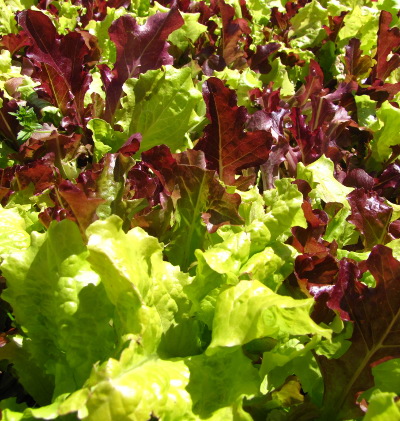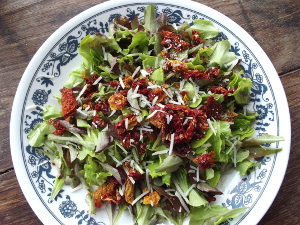
DIY gourmet salad mix
 Do
you want to grow a variety of gourmet salad greens? Seed mixtures
are available, but they're generally quite expensive, and can also be
problematic in the garden. I've also found that the lettuce
varieties that come in seed mixtures aren't as tasty as the ones I've
hand-picked to suit our palates and garden.
Do
you want to grow a variety of gourmet salad greens? Seed mixtures
are available, but they're generally quite expensive, and can also be
problematic in the garden. I've also found that the lettuce
varieties that come in seed mixtures aren't as tasty as the ones I've
hand-picked to suit our palates and garden.
On the other hand, who
doesn't enjoy a diverse array of colors, shapes, and flavors on their
plate? Here are my tips for making your salad bowl gourmet the
Walden Effect way:
- Plant non-lettuce salad greens in a separate bed. Many seed mixtures include non-lettuces like arugula, spinach, and Asian greens for an extra flavor burst. However, these salad greens tend to grow differently than lettuce, maturing at a different rate, so they do better in their own garden bed. It's easy to snip a few leaves of arugula to add to your salad bowl while you're in the garden collecting dinner, and separating out the non-lettuces also allows you to add more or less of the spicy plants depending on your guests and meal plan.
 Mix lettuces by hand. When I was
ordering seeds this spring, the cheapest salad seed mixture at Johnny's
was $14.65 per quarter pound. In contrast, my favorite green leaf
lettuce (Black-seeded Simpson) was $7.45 per quarter pound and the
equally delectable Red Saladbowl was $9.30 per quarter pound. I
bought the red and green leaf lettuce seeds separately, mixed them as I
tossed the seeds in the bed, and saved 43%. (I could also have
given each lettuce its own bed, but different varieties of lettuce play
well together, so there was no real reason to segregate them.
However, some unusual lettuces like escarole might do better alone.)
Mix lettuces by hand. When I was
ordering seeds this spring, the cheapest salad seed mixture at Johnny's
was $14.65 per quarter pound. In contrast, my favorite green leaf
lettuce (Black-seeded Simpson) was $7.45 per quarter pound and the
equally delectable Red Saladbowl was $9.30 per quarter pound. I
bought the red and green leaf lettuce seeds separately, mixed them as I
tossed the seeds in the bed, and saved 43%. (I could also have
given each lettuce its own bed, but different varieties of lettuce play
well together, so there was no real reason to segregate them.
However, some unusual lettuces like escarole might do better alone.)
No matter where the
seeds come from, leaf lettuce is the very first crop I'd recommend
beginning gardeners plant, as long as they hurry up and do so before
summer heat kicks in. Plant your lettuce today and you can be
eating it within a month, and that dollar's worth of seed could feed
you up to 60 meals! Now that's low cost gourmet food.
Want more in-depth information? Browse through our books.
Or explore more posts by date or by subject.
About us: Anna Hess and Mark Hamilton spent over a decade living self-sufficiently in the mountains of Virginia before moving north to start over from scratch in the foothills of Ohio. They've experimented with permaculture, no-till gardening, trailersteading, home-based microbusinesses and much more, writing about their adventures in both blogs and books.
Want to be notified when new comments are posted on this page? Click on the RSS button after you add a comment to subscribe to the comment feed, or simply check the box beside "email replies to me" while writing your comment.

If lettuce is such a great plant for a beginning gardener, why can't I grow it? Is there some secret? I tried direct-seeding it, but none sprouted. So I tried again, at different depths from 1/2 an inch to right on the surface, and I finally did end up getting about five plants from 100 seeds or so. I tried growing it inside and transplanting it, but all my transplants died. Other things grow fine in that patch of dirt. It's just the lettuce I can't do!
How deep do you plant your lettuce seeds? Is there anything special you do to get them to sprout? I have heavy clay soil -- could that be my problem?
I scatter seeds pretty thick on the soil surface (not covering them at all), and they tend to pop up as soon as the ground gets well soaked. I wouldn't try to transplant them --- too delicate (and you shouldn't need to).
It's important to plant them when the weather's cool, though --- they're not a summer crop. Once the soil temperature gets above 80 or so, they're very unlikely to sprout. I plant ours in February (under protection) through April, then again in the late summer for a fall crop.
I hope that helps! I don't think your clay soil would be the problem since we have the same.